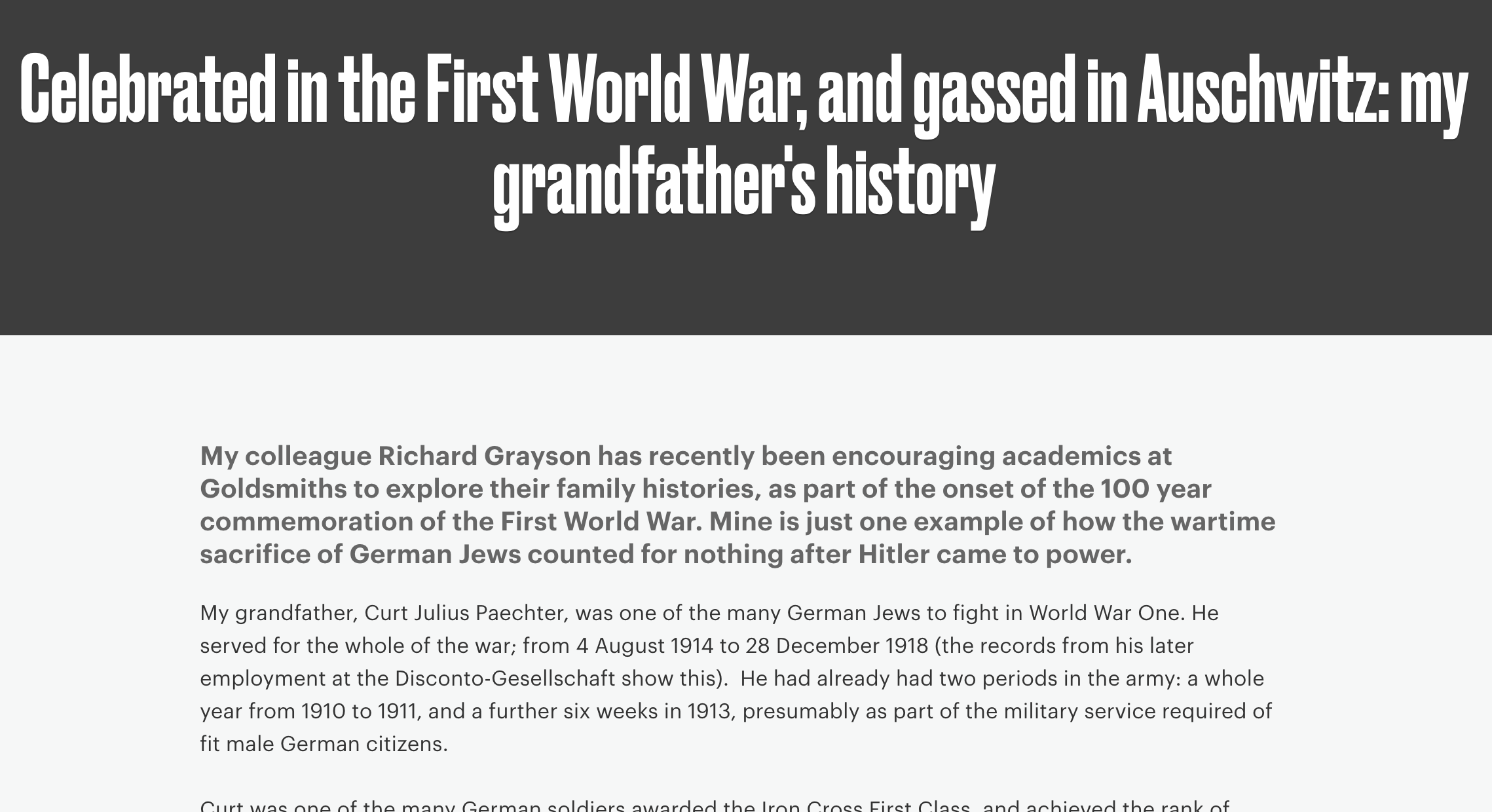Carrie Paechter's tribute to her grandfather
I began to piece together the story of the Paechter children after they came to England from this 2016 posting by a British social scientist named Carrie Paechter. She refers to her father George Paechter, who must be the second son of Kurt and Grete Paechter. In Germany, he was named Gerd.
The essay by Carrie Paechter was part of a project about the memory of war at an interdisciplinary college of the University of London where she was then a professor. Keep in mind that her memories of her grandfather are second-hand. They are stories she heard from her father.
Celebrated in the First World War, and gassed in Auschwitz: my grandfather's history
My colleague Richard Grayson has recently been encouraging academics at Goldsmiths to explore their family histories, as part of the onset of the 100 year commemoration of the First World War. Mine is just one example of how the wartime sacrifice of German Jews counted for nothing after Hitler came to power.
My grandfather, Curt Julius Paechter, was one of the many German Jews to fight in World War One. He served for the whole of the war; from 4 August 1914 to 28 December 1918 (the records from his later employment at the Disconto-Gesellschaft show this). He had already had two periods in the army: a whole year from 1910 to 1911, and a further six weeks in 1913, presumably as part of the military service required of fit male German citizens.
Curt was one of the many German soldiers awarded the Iron Cross First Class, and achieved the rank of Leutnant. When he joined the Disconto-Gessellschaft he described himself as Leutnant der Reserve, presumably because he was no longer on active service.
A story about him told by my father, George Paechter, is all we know of his active service, but it shows that he was brave under fire: "Curt was in the cavalry, and, at one time, had to cross an avenue in woodland down which the enemy were firing intermittent cannons. He didn't time his crossing very well: his horse was decapitated, but managed to carry him over to the other side before collapsing."
Curt was very much an assimilated German Jew. The only description we have of him is from the memoirs of my great-aunt, Anneliese Landau, who left Germany in 1939 and was the only member of that generation of my family to survive.
She describes her first impressions of him as: “a slender, middle-sized young man with steel-blue eyes, a slightly balding head and a blond moustache. The erect figure seemed to be a model of a Prussian E.K.1 officer of the First World War: correctness all over, a face that seemed set for making decisions which no one could change, hardly even he himself who had originally made them.”
In civilian life, Curt was a lawyer, and in 1920 he took up a position as head of the law department of the Disconto-Gessellschaft, which later became part of the Deutsche Bank, specialising in their property holdings.
Following the rise of the Nazis in the 1930s, he was dismissed from this job, because Jews were no longer permitted to work as lawyers in such organisations.
Following Kristallnacht, he was arrested on 9 November 1938 and imprisoned for three months. After this, he sent his three children, including my father, to England as refugees. He and my grandmother Grete remained in Berlin to take care of their own parents.
Grete died from appendicitis in 1941 and Curt remained in Berlin with his mother and in-laws until 1942. In that year, he was deported to Theresienstadt. From there, probably sometime in 1944, he was sent to Auschwitz, where he died, probably in the gas chambers. There is a Stolperstein (stumbling block) in his memory outside the apartment block in which the family lived at 61 Nassauischestrasse in Berlin.

